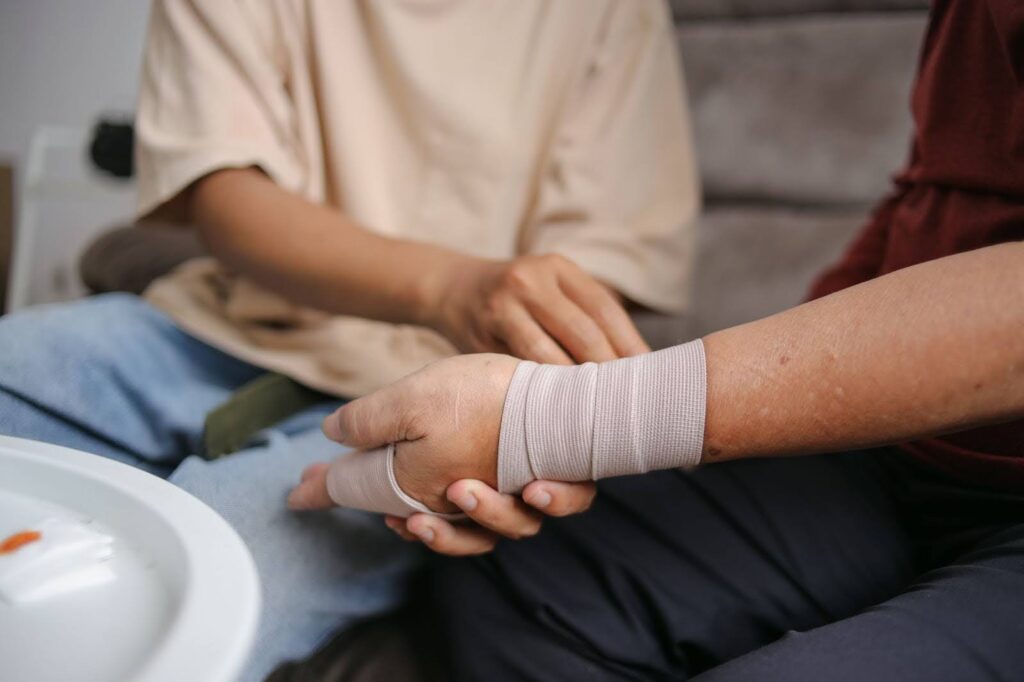
The Connection Between Circulation and Healing Wounds
The connection between circulation and healing wounds lies at the heart of the body’s natural repair process. At the same time, it’s easy to focus on the visible characteristics of a wound—such as size, depth, or location—the fundamental determinant of healing often occurs beneath the surface, within the vascular system. Blood circulation is crucial for delivering oxygen, nutrients, and immune cells, as well as removing waste from the wound site. When this circulation is impaired, the body’s ability to repair itself slows dramatically, increasing the risk of infection, tissue damage, and chronic wound development. Our team takes a comprehensive approach to wound care, considering the critical role of circulation, particularly for individuals managing chronic conditions or compromised vascular health.
Why Circulation Matters in Healing Wounds
Once the skin is damaged, the body initiates a multi-phase process that includes inflammation, tissue regeneration, and remodeling. Blood vessels at the site first constrict to minimize bleeding, then quickly dilate to allow clotting factors and platelets to seal the wound. White blood cells follow to fight potential infection, while oxygen-rich red blood cells rush in to support tissue repair. This entire healing cascade depends on sufficient blood flow. When circulation is compromised, fewer immune and repair cells reach the wound, slowing cellular activity and weakening the body’s defense mechanisms. Without adequate oxygen and nutrients, wounds are more likely to heal slowly, worsen over time, or develop complications like infection, necrosis, or chronic inflammation.
Therapeutic Strategies to Improve Circulation for Healing Wounds
Medical professionals employ a range of techniques to enhance circulation and promote wound healing, particularly in patients with compromised vascular health. These targeted interventions aim to enhance oxygen delivery, improve nutrient transport, and create a more favorable environment for tissue repair and regeneration.
Compression Therapy
Compression therapy plays a crucial role in treating venous-related wounds by helping veins return blood to the heart and reducing swelling that can impede healing. By improving blood return, it also helps reduce the risk of fluid buildup and tissue breakdown in the lower limbs.
Vascular Surgery
In cases of blocked arteries, vascular surgery or angioplasty can restore circulation and significantly improve the conditions needed for effective wound healing. These interventions are often critical for preventing tissue loss and reducing the chances of limb amputation in severe cases.
Hyperbaric Oxygen Therapy (HBOT)
Hyperbaric oxygen therapy (HBOT) offers a powerful solution for oxygen-deprived wounds by delivering concentrated oxygen in a pressurized chamber, enhancing oxygen absorption at the tissue level. This therapy not only accelerates healing but also strengthens the body’s ability to fight infection.
Topical Treatments
Topical treatments that promote circulation can aid wound healing directly at the site by stimulating blood flow and cellular regeneration. When used in conjunction with other therapies, these treatments can accelerate the formation of granulation tissue and overall recovery.
Electrical Stimulation and Ultrasound Therapy
Advanced therapies, such as electrical stimulation and ultrasound, are utilized to enhance microcirculation and stimulate the wound environment, thereby improving healing outcomes. These methods also support cell regeneration, reduce inflammation, and may help re-establish nerve function in some patients.
The Role of Oxygen in Wound Recovery
Oxygen plays a vital role in wound healing by supporting collagen production, immune response, and the formation of new blood vessels. Adequate oxygenation, delivered through healthy circulation, helps wounds heal efficiently and reduces the risk of complications. In contrast, low oxygen levels—often caused by conditions like PAD, diabetes, or heart failure—can delay healing and increase infection risk. Improving blood flow is crucial to ensure that wounds receive the necessary oxygen for proper healing and recovery.

How Blood Vessels Support the Healing of Wounds
Blood vessels serve as critical healing pathways by delivering oxygen, nutrients, and growth factors to the wound site while removing waste and dead cells. When vessels are damaged or narrowed, this exchange is disrupted, slowing recovery and increasing the risk of complications. In severe cases—like arterial ulcers or diabetic foot wounds—healing may stop entirely. This lack of healing makes vascular health an essential focus in effective wound care. Regular assessment of circulation helps guide treatment decisions and improves the chances of successful wound healing.
Circulatory Disorders and Their Impact on Wounds
Several circulatory disorders can affect the body’s ability to heal wounds efficiently. Among the most common are conditions that limit blood flow, impair oxygen delivery, or interfere with waste removal—each of which can significantly delay or complicate the healing process.
Peripheral Artery Disease (PAD)
This condition causes narrowing or blockage of the arteries, especially in the legs. Reduced blood flow makes it difficult for wounds on the lower extremities to receive the oxygen and nutrients they need to heal.
Diabetes
Diabetes affects both microvascular and macrovascular systems. High blood sugar levels damage blood vessels over time, leading to poor circulation and nerve impairment. Diabetic foot ulcers are a well-known complication that is often resistant to healing due to inadequate blood supply.
Venous Insufficiency
In this condition, veins struggle to return blood to the heart, often causing fluid buildup and pressure in the lower legs. The result can be venous ulcers—wounds that are slow to heal due to poor waste removal and nutrient exchange.
Cardiovascular Disease
Generalized heart dysfunction can reduce the body’s circulatory efficiency, leading to impaired tissue perfusion. Poor cardiac output means that less blood reaches peripheral tissues, especially during times of increased demand, such as wound healing.
The Relationship Between Inflammation, Blood Flow, and Wounds
How inflammation and blood flow interact plays a significant role in wound healing. Inflammation is a normal part of the body’s response to injury, working to eliminate pathogens, clear dead cells, and trigger tissue repair. However, when circulation is poor, inflammatory cells can accumulate at the wound site, prolonging the response and leading to excessive cytokine release and tissue breakdown. In contrast, healthy blood flow allows these cells to arrive quickly, perform their function, and exit as healing advances. Enhancing circulation not only supports nutrient delivery but also helps resolve inflammation, enabling the wound to progress in the healing process.
The Link Between Nerve Health and Blood Flow in Wound Care
The link between nerve health and blood flow in wound care is a crucial yet often overlooked aspect of healing. Nerves play an essential role in regulating the dilation and constriction of blood vessels, directing circulation to areas that need it most. When nerve function is compromised—as in diabetic neuropathy or spinal cord injury—these circulatory responses can become irregular or diminished, resulting in delayed or impaired wound healing. Additionally, damaged nerves may reduce a person’s ability to feel pain or pressure, leading to unnoticed injuries that worsen over time. For this reason, effective wound care must address both vascular and neurological health.
Why New Blood Vessel Formation is Essential for Healing Wounds
The importance of new blood vessel formation lies in the body’s ability to restore circulation to healing tissue through a process called angiogenesis. As wounds progress into the later stages of healing, the formation of new blood vessels becomes essential for delivering a steady supply of oxygen and nutrients to regenerating cells. Growth factors, such as VEGF (vascular endothelial growth factor), play a key role in triggering this process; however, poor circulation can weaken or disrupt these signals. Without proper angiogenesis, tissue repair slows, and scars may form weakly or incompletely. Supporting this critical phase through strong vascular health is essential for fully closing wounds and building resilient tissue.
Lifestyle Factors That Influence Circulation and Wounds
Circulatory health isn’t determined by genetics or medical conditions alone. Lifestyle choices can significantly influence how efficiently blood flows through the body—and, by extension, how quickly wounds heal.
Physical Activity
Engaging in physical activity encourages healthy circulation by stimulating the heart and blood vessels. Even light, consistent movement can enhance blood flow to the extremities, reduce inflammation, and support oxygen delivery to healing tissue.
Nutrition
Maintaining proper nutrition plays a crucial role in maintaining circulation and facilitating wound repair by supplying the body with essential nutrients. A diet rich in antioxidants, lean proteins, healthy fats, and vitamins like C, E, and zinc supports vascular health, while dehydration can thicken the blood and impair circulation.
Smoking
Smoking significantly harms circulation and impedes wound healing by constricting blood vessels, lowering oxygen levels in the blood, and damaging arterial walls. These effects collectively reduce the body’s ability to deliver the nutrients and oxygen needed for effective tissue repair.
Stress Management
Managing stress is a crucial yet often overlooked factor in wound healing, as chronic stress elevates cortisol and inflammation levels, both of which can disrupt circulation and immune function. Mindfulness practices, adequate rest, and emotional support can improve overall healing outcomes by promoting better blood flow.
Aging and Its Effects on Circulation and Wound Healing
Aging and its effects on circulation and wound healing become more apparent as natural changes in the cardiovascular system reduce blood flow to the extremities. With age, blood vessels lose elasticity, and the heart may become less efficient, leading to slower healing, a weaker immune response, and an increased risk of complications from minor injuries. Conditions like arteriosclerosis, fragile skin, and limited mobility add to the challenge. Staying active, eating a heart-healthy diet, and monitoring wounds closely are key to supporting circulation and promoting effective healing in older adults.
Early Detection and Circulatory Assessment for Managing Wounds
Early detection and circulatory assessment play a critical role in effective wound management. Non-invasive tools, such as Doppler ultrasound, ankle-brachial index (ABI), and transcutaneous oxygen measurement, offer valuable insights into vascular health and help identify reduced perfusion before a wound becomes chronic or infected. Simple daily checks—like monitoring skin temperature, color, or capillary refill in the feet or hands—can also reveal early signs of circulation issues. Ongoing education and consistent monitoring empower both patients and caregivers to take proactive steps in preventing wound-related complications.
Integrated Care for Optimal Wound Healing
Wound healing is never just about the surface—it involves caring for the whole body, especially the systems that provide essential nourishment and support tissue health. Integrated care that addresses circulation, nutrition, mobility, and chronic disease management is vital for optimal healing. A multidisciplinary team, including wound care specialists, vascular physicians, physical therapists, and nutritionists, coordinates efforts to optimize outcomes for patients with complex or chronic wounds. Combining clinical expertise, patient education, and personalized therapies ensures that every wound has the best chance of healing fully and efficiently.

Prioritizing Circulation for Better Wound Healing Outcomes
The connection between circulation and healing wounds is essential, influencing how well oxygen, nutrients, immune cells, and waste are transported to and from the wound site. When blood flow is impaired, wounds may heal slowly, become chronic, or develop complications, such as infection. Addressing circulation as a core component of wound care can significantly improve healing outcomes and overall well-being. Through a combination of lifestyle changes, clinical monitoring, and targeted therapies, it’s possible to support vascular health and give wounds the best chance to close, strengthen, and fully recover.
To learn more about the connection between circulation and healing wounds, visit our Stem Health Plus blogs.
